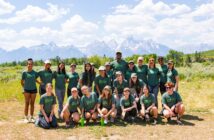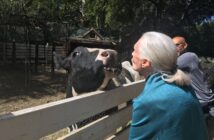Conservation often feels like a never-ending challenge, which is why a little bit of encouraging news goes a long way! Today’s hope-filled news comes from a recent study in the American Journal of Primatology out of the Democratic Republic in the Congo (DRC) led by Wildlife Conservation Society (WCS) funded in part by the Jane Goodall Institute. In this study, analyzed wildlife surveys revealed some surprising and amazing revelations using rigorous measurements. The conclusion: there is a larger population estimate for the critically endangered Grauer’s gorillas than previously reported, and a stable population of chimpanzees! Bonus: They are largely in wild areas outside of national parks which have benefited from the land-buffers created in many instances through community-managed forest areas. Though conservation threats continue to loom as great ape populations decline across their range, this stronger population estimate, and these other affirming findings of greater presence outside protected areas, underscore the incredible power of the cross-sectoral collaboratives and community-led conservation in Eastern DRC.
What’s the situation?
Grauer’s gorillas were declared critically endangered by the IUCN Red List of Threatened Species after wildlife surveys in 2016 reported only 3,800 individuals globally. These great apes, along with other species like chimpanzees face a variety of threats in the DRC, including mining, illegal wildlife trafficking, unsustainable human development, and civil unrest. To address these issues, JGI has worked as the head of the Ushiriki Consortium, whose name means ‘union’ in Kiswahili, and includes representatives from a group of over 20 non-profits, government officials, individuals, and more. The group has been managing and implementing the Eastern DRC Great Ape Conservation Action Plan since 2012 and focuses on ways to address the drivers of threats through a community-led approach. This survey was a huge part of next steps for the group, as it finally delivered on the best possible calculations and estimates for populations and most crucially where these great apes primarily remain. With these new data, even more efficient decision-making can take place to focus on efforts in the areas where great apes are, and to dive deeper into community-led forest management and other initiatives that we know work.
How Did They Do it?
Previously, since data could not be collected from many of the areas where great apes live in the DRC (due to difficult terrain and civil unrest) researchers relied mainly on mathematical formulas. Estimating populations of primates is always an imperfect science but using rigorous methods in the field can give us much better accuracy. Thanks to the bravery and fortitude of the Congolese biologists who completed these wildlife surveys over nine years, the global population estimate of Grauer’s gorillas has gone from 3,800 individuals to 6,800! In addition, chimpanzee populations in the area were found to be relatively stable. This is welcome news and provides some possible hope for great apes in the region.
What Does This Mean?
It is important to keep in mind that these numbers are still low, and that Grauer’s gorillas and chimpanzees are still critically endangered. Almost all great ape populations on the planet are declining, and while we would love to see their populations increasing in the wild, reversing the trend isn’t always simple. This is because the array of threats are complex, often interconnected, and increasing every day. What we can hope for is a decrease in the decline — in other words, population stability and human coexistence.
Why Community-Led Conservation?
Prominent in the report is how these surveys reflect the importance of community forest protection and management. Much of the global Grauer’s gorilla population resides outside of protected areas such as Kahuzi-Biega National Park, including in areas like the Oku community forest. In fact, the latter seems to have the greatest population of Grauer’s gorillas!
This is significant information because it validates JGI’s community-based conservation approach, known as ‘Tacare,’ and the incredible advantages of collective community-level planning and impact. JGI’s community-led conservation approach – Tacare – focuses on addressing drivers of threats, like inequity, lack of access to resources and education, and other factors. These drivers are what ultimately cause issues like illegal wildlife crime and deforestation. Community-led conservation also acknowledges the ownership of local people to manage their lands and ecosystems, as well as the essential importance of local knowledge.
The study also demonstrates that much of the population of chimpanzees and Grauer’s gorillas live beyond a “buffer” distance of 5-7 miles away from human communities. Because we know that many of the best spaces for great apes are outside of national parks and some distance away from humans, these “buffer” forests are incredibly important for the conservation of biodiversity. Most excitingly, many of these buffer forests were created through land-use planning and community managed and owned forests. Thanks to the approach of community-management of biodiverse areas and the Ushiriki Consortium in the Eastern DRC (led by JGI), we may be witnessing the clear benefits of supporting local people in securing community-managed forests.
What’s Next for Great Apes?
At JGI, we believe in hope turned into action. Because this is just a glimmer of hope, we need all the support we can get to advance this work if we dream of conserving these amazing species. Without these interventions, and with the looming existential threat of climate change, great apes — our closest living relatives in the animal kingdom — could be gone in the next century. Luckily, the JGI-led Ushiriki Consortium continues to work with local communities in DRC to support sustainable livelihoods, education, access to healthcare, and community-ownership of forests for Grauer’s gorillas and other species.
There is still much work to do, but we can at least use this hope to fuel us in ensuring a fighting chance for Grauer’s gorillas, chimpanzees, and other great apes. Ultimately, community focused initiatives like the JGI-led Ushiriki Consortium that protect biodiversity outside of ‘Protected Areas’ hold the greatest potential for the future of great apes.
Together, we can make sure that humans, wildlife, and the planet we share thrive today and for years to come.






